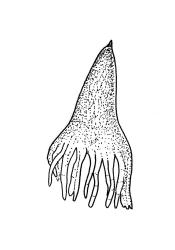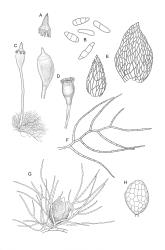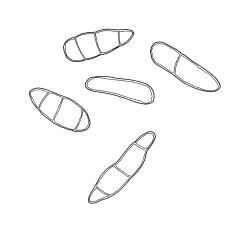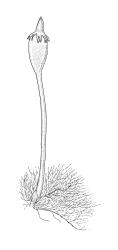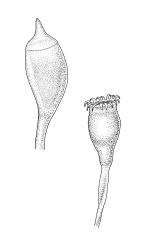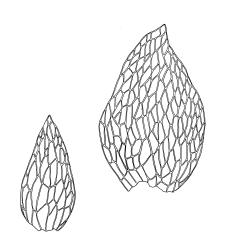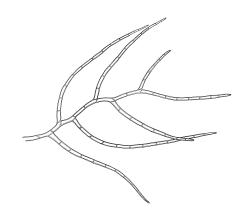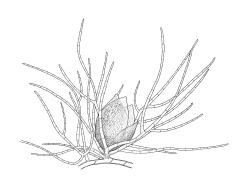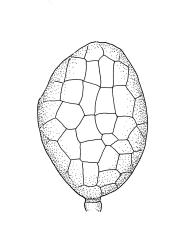- ≡ Archephemeropsis trentepohlioides Renner, Ann. Jard. Bot. Buitenzorg 44: 88 (1935)
Plants red-brown, appressed to twigs or rarely epiphyllous. Protonema red-brown in mass, and forming dense wefts; primary protonema with oblique walls, lacking holdfasts, directly giving rise to ♂ and ♀ buds; secondary protonema with transverse walls, lacking both conspicuous terminal filaments and brood bodies. Shoots as per genus. Vegetative leaves absent.
Autoicous (with ♂ and ♀ buds arising from the same primary protonema). Perichaetial leaves c. 4 per perichaetium, in form as per ♂ bracts. Perigonia ellipsoid, c. 300 μm long, bracts c. 4, brownish, broadly ovate, acute, c. 250–300 × 120–195 μm, with median laminal cells oblong-hexagonal, firm-walled, and mostly 36–48 × 9–15 μm; antheridia on 2-celled stalks, ellipsoid, c. 125 μm long. Setae 1–3 mm, red-brown, scarcely twisted; capsules oblong-turbinate, green-or red-brown at maturity, appearing strongly papillose when dry, with columella persistent and occasionally exserted, 0.5–0.7 (–0.8) mm long; exothecial cells isodiametric or ± quadrate, thin-walled or with transverse walls moderately thickened, distinctly collenchymatous; stomata cryptopore, few and scattered in neck or sometimes apparently absent; annulus not observed; operculum pale, rostrate, c. 0.3 mm. Exostome teeth 16, paired, strongly reflexed when dry, incurved with moist, not furrowed, c. 150 × 40 μm, with median zig-zag line extending c. ⅓ the tooth length or absent; outer surface transversely striate; inner surface with numerous low lamellae and roughly equal in tangential width to the outer layer at mid tooth; in cross-section with the inner layer of tooth radially thicker than the outer layer (c. 18 µm vs. c. 3–4 μm); endostome with a very low (or sometimes apparently absent) basal membrane, with both segments and cilia absent. Calyptra mitrate, laciniate-ciliate at base. Spores fusiform, clavate, or oblong, with (0–)1–3 transverse septa, 60–96 × 27–30 μm, occasionally germinating in capsule.
Renner 1935, figs 24–27, 29 a–d, 37–40; Sainsbury 1955, pl. 62, fig. 1; Beever et al. 1992, fig. 66; Dalton 1998, pl. 1, figs b–d; Malcolm & Malcolm 2003, p. 27; Malcolm & Malcolm 2006, p.130.
There is no moss in the N.Z. flora that could be mistaken for T. trentepohlioides. It is often confused or overlooked because of its minute size and because of its similarity to the green alga genus Trentepohlia (which is typically bright orange in colour) but the sporophyte here immediately identifies T. trentepohlioides as a moss belonging to the Daltoniaceae. Microscopically, the presence of oblique cross-walls in the primary protonema precludes confusion with any green algal filament, which has transverse cross-walls.
NI: S Auckland, Wellington (Mt Ruapehu, Mt Hauhungatahi); SI: Nelson (Porika Stream, Donald Creek, Little Totara River, Lewis Pass), Marlborough (Pelorus Bridge Scenic Reserve), Canterbury (Peel Forest), Westland, Otago (Haast Pass, Hollyford Valley), Southland (Doubtful Sound, Spey River). Ephemeropsis trentepohlioides is a common species in Westland and apparently also in parts of the North I., including the Rotorua/Ātiamuri region.
Australasian. Tasmania*. Reported from Tasmania by Dalton (1998) and earlier by Willis (1953). Recorded from the Otway Ranges of Victoria (D. Meagher, pers. comm., 28 Aug. 2016).
Occurring on living and dead twigs and small branches of a number of native shrubs and trees including Aristotelia serrata, Coprosma cf. parviflora, C. propinqua, C. rotundifolia, Leptecophylla juniperina, Fuchsia excorticata, Gaultheria sp., Leptospermum scoparium, Lophozonia menziesii, Melicope simplex, Neomyrtus pedunculata, Pennantia corymbosa, and especially Pseudowintera colorata. Rarely epiphyllous on P. colorata and also known from dead fronds of Lycopodium deuterodensum and the trunks of introduced conifers (Larix decidua and Pinus nigra subsp. laricio). Occurrences on introduced tree species are known only from the volcanic plateau on the central North I. It is a rare plant east of the Main Divide on the South I. Ranging from c. 300–800 m in the central North I. and from c. 60–560 m on the South I. It is frequently associated with Crosbya nervosa, Daltonia splachnoides, Tetraphidopsis pusilla, and various species of Frullania, Lejeuneaceae, and Metzgeria.
Although sometimes found in damp forest, Ephemeropsis is most abundant in open scrub and forest margins in areas of heavy and evenly distributed rainfall; it thrives in scrub with nearly constant high humidity and high levels of insolation. On alluvial terraces and open road margins where such conditions prevail (as at Kellys Creek and Lake Kaniere, both Westland L.D.) this species is sometimes very common.
The description of the sexuality of this species is problematic. To my knowledge there is no accepted term to describe the autoicous condition in which the ♂ and ♀ gametangia arise from a common protonema, as here. Fleischer (1908) applied the term rhizautoicous to E. tjibodensis, but this term describes plants in which gametangia are connected by rhizoids, rather than by protonemal filaments. Germinating spores can frequently be found amongst the protonemal wefts of E. trentepohlioides, and these could easily be incorrectly interpreted as brood bodies.



